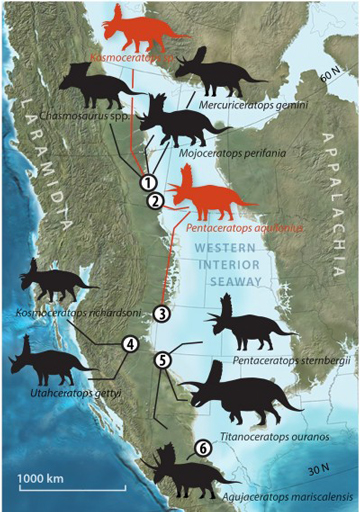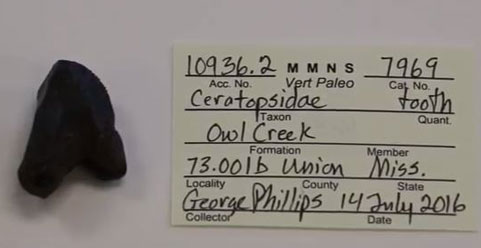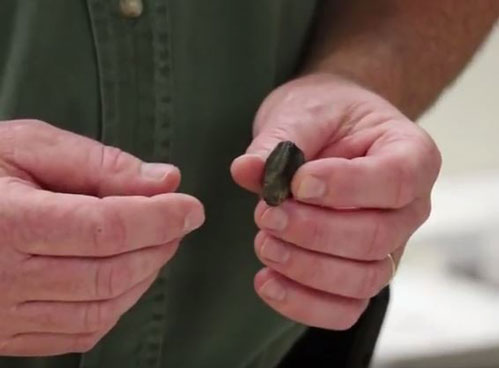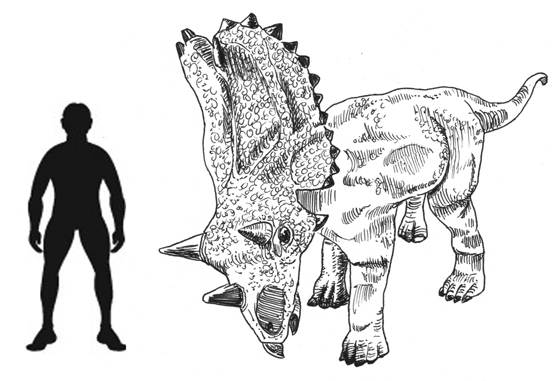Horned Dinosaur Tooth Discovered in Northern Mississippi
Horned Dinosaurs Roamed Appalachia
For much of the Cretaceous, North America was split into two landmasses by a huge sea (the Western Interior Seaway), much is known about the variety of dinosaurs that roamed the land to the west of this seaway (Laramidia), we have the Cretaceous rock formations of New Mexico, Utah, Montana and southern Alberta to thank for that. In comparison, palaeontologists know very little about the dinosaurs that roamed the eastern landmass, a much larger area of land called Appalachia. Thanks to a lucky fossil find in northern Mississippi, scientists have found further evidence to indicate that horned dinosaurs made up part of the plant-eating dinosaur population on Appalachia.
A single fossil tooth, suggests that a car-sized ceratopsian lived in Mississippi some sixty-seven million years ago. The tooth represents the first evidence of horned dinosaurs having roamed the “Magnolia State”.
During the Late Cretaceous Many Types of Horned Dinosaur Roamed Laramidia – What about Appalachia?
Picture credit: University of Bath
The Discovery of a Ceratopsian Tooth
George Phillips, a curator at the Mississippi Museum of Natural Science was exploring a river bed near New Albany when he made the fossil find. The strata exposed in this part of northern Mississippi make up a geological sequence called the Owl Creek Formation. These deposits date from the Upper Cretaceous (Maastrichtian faunal stage) and represent marine deposits. During the Late Cretaceous, the State of Mississippi was largely submerged beneath a shallow arm of the Western Interior Seaway that extended up the Mississippi River Valley to the southern tip of Illinois. This body of water is referred to as the Mississippi Embayment.
Visit Everything Dinosaur’s website: Everything Dinosaur.
The layers of rock yield a variety of marine fossils, particularly bivalves, gastropods and ammonites, but vertebrate remains are rare. Mosasaur fossils are associated with northern Mississippi and very occasionally evidence emerges of dinosaurs, animals that inhabited the coastal swamps and low lying inland areas that bordered the Western Interior Seaway.
A Photograph of the Fossil Tooth (Ceratopsidae)
Picture credit: Mississippi Museum of Natural Science (MDWFP)
Six Types of Late Cretaceous Dinosaur Known from the State of Mississippi
Very little is known about the dinosaur fauna of the State of Mississippi. Everything Dinosaur wrote an article about dinosaur discoveries in the American States back in 2015, after we reported on the discovery of a partial dinosaur femur from Washington State, Everything Dinosaur team members attempted to plot which of the fifty U.S. States did not have dinosaur fossils. In the resulting article we incorrectly discounted a number of dinosaur fossil discoveries from Mississippi, although the fossils are extremely fragmentary the ceratopsid tooth represents the sixth type of dinosaur known to have existed in northern Mississippi.
The five different types of dinosaur from Mississippi:
- Tyrannosaurids
- Hadrosaurs (duck-billed dinosaurs)
- Ornithomimids (ostrich-like dinosaurs)
- Dromaeosaurids (raptors)
- Nodosaurid (armoured dinosaur)
- Indeterminate Ceratopsidae (the fossil tooth found on July 14th 2016 indicates the presence of horned dinosaurs)
To read our article mapping the dinosaur fossil discoveries of America: The Dinosaur Fossil Discoveries of America.
The Importance of the Horned Dinosaur Tooth
George Phillips explained:
“This particular tooth is from a group of dinosaurs that is very poorly documented as to the Mississippi River and is the first of its kind ever found in the south-east.”
The Mississippi Museum of Natural Science curator explained how he felt when he first spotted the fossil:
“Oh, I was very excited. I knew it was a dinosaur. I miss-identified it initially but after a social media post my colleagues put me on the right track. Dinosaurs in general from Mississippi are very rare.”
Handling the Extremely Rare Fossil Find
Picture credit: Mississippi Museum of Natural Science (MDWFP)
The tooth has broken roots and looks like it has been subject to a lot erosion, however, it remains a significant find as it is one of only three ceratopsian fossils to have been found in eastern North America.
To read an Everything Dinosaur article about the chance discovery of a fragment of dinosaur jawbone in the Peabody Museum at Yale University that indicates basal ceratopsids inhabited eastern North America: Late Cretaceous Eastern North America and Leptoceratopsids.
At this stage it is not possible to determine whether the horned dinosaur was a member of the centrosaurine group or the chasmosaurine group of horned dinosaurs. A copy of the specimen is on its way to California for further analysis and study.
A Picture of a Late Cretaceous Horned Dinosaur
Picture credit: Everything Dinosaur
For articulated replicas of horned dinosaurs and other prehistoric animals: Beasts of the Mesozoic Models.





